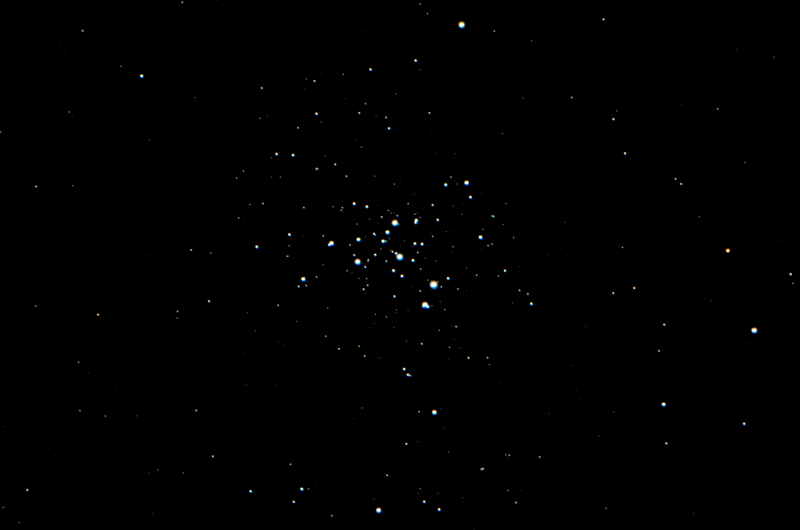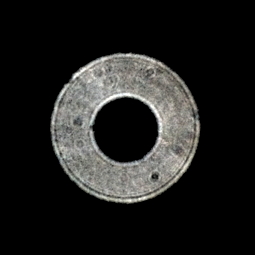
Imaging: Saturn, NGC6231 Open Cluster;
Lots of DSO Observing
Posted: 28 June 2014
|
Opened: Friday, 27 June 2014, 1939 MST Temperature: 91°F |
Session: 700 Conditions: Clear, breezy |
As I was walking to the observatory the sun was beginning to set behind distance mountains. I watched it set and saw the "Green Flash".
After opening the observatory I viewed Jupiter, very low in the west, 83X. 1948 MST. The telescope was then slewed to Mars. Viewed it at 83X and 222X. No details were seen at 83X. Using 222X the North Polar Cap was the only surface detail visible. Seeing was not ideal, probably due to the breezes, which were strong at times. 2002 MST: added the 2X PowerMate to bring the magnification to 444X. There was a faint dark area visible around the South Pole, but seeing was really not good enough for that much magnification.
2010 MST: viewed Saturn, 222X. Seeing was not steady but it was still a nice view. Five moons were visible: Iapetus, Titan, Dione, Tethys, and Rhea. I decided to try some iPhone 5s imaging. I did 25 1 second slo-mo (120 fps) video recording. During post-processing I stacked each the best individual videos, edited the resulting images, and then stacked the best remaining 18 images. The image on the left is the best single video stack and the image on the right is the final stack of the 18 images:


2030 MST: resumed observing Saturn, 222X. Tried to see the moon Enceladus. No success.
2042 MST: I began doing Deep Sky Object (DSO) observing. First was Omega Centauri (globular cluster) using 222X. It appeared faint with that amount of magnification on the 8" telescope but was still a good view. Switched to a 2" 50mm (40X) eyepiece and would use it for most of the DSO observing. Although the sky was bright (30 minutes before end of Astronomical Twilight and the object was low into the Tucson light dome), the view of Omega Centauri at this low power was very nice. Next viewed M13 (globular cluster); great view. M92 (globular cluster) was small but nice. M57 (Ring Nebula) was small but lovely in the wide star field at this low magnification. Next was M56 (globular cluster); small but good. M22 (globular cluster), low in the southeast, was very nice. The breezes began dying down.
2105 MST: began an AutoStar tour of DSOs in the constellation of Scorpius, 40X: M80 (globular cluster), M4 (globular cluster), NGC6124 (open cluster), NGC6231 (open cluster), NGC6302 (Bug Nebula, planetary nebula), M6 (Butterfly Cluster, open cluster), and M7 (open cluster). I think NGC6231 could be my favorite open star cluster. It has a nice mix of bright and faint stars, giving a nice appearance at low magnification. I don't normally photograph open star clusters but couldn't pass this one up.
Mounted the D7000 DSLR at prime focus and did a focus test on Antares using a Bahtinov Mask. This is a 10 second, unguided, ISO 1600 exposure of NGC6231:

2135 MST: resumed DSO observing at 40X with a 2" O-III filter. First was NGC6888 (Crescent Nebula); nebula very obvious using averted vision. NGC6960 (Veil Nebula); very large with the brightest portion easy to see; fainter portions (which had to slew to view) were also visible. IC5067 (Pelican Nebula); very faint and difficult to see using averted vision. NGC6992 (diffuse nebula); very nice with a surprising amount of structure visible; had to slew to see it all. M17 (Swan Nebula); great view with lots of faint nebulosity visible using averted vision. M16 (Eagle Nebula); large with obvious structure visible. Removed the O-III filter and viewed M16; nebulosity was less visible.
2211-2237 MST: took a short break. Swapped the AutoStar II rechargeable batteries.
2245 MST: did some sky quality measurements using a Unihedron SQM-L meter and compared the results to the iOS app "Dark Sky Meter" (Pro version). Cassiopeia Observatory was SQM 21.37 this night.
2305 MST: tour of DSOs in Sagittarius, 40X: M23 (open cluster), M20 (Trifid Nebula), M8 (Lagoon Nebula), M21 (open cluster), NGC6530 (open cluster), M24 (open cluster), M18 (open cluster), M17 (Swan Nebula), M28 (globular cluster), M69 (globular cluster), M25 (open cluster), M22 (globular cluster), M70 (globular cluster), M54 (globular cluster), M55 (globular cluster), NGC6822 (Barnard's Galaxy), and M75 (globular cluster).
2325 MST: returned to NGC6822 (Barnard's Galaxy) to compare the view using the 2" 50mm (40X) eyepiece vs the 2" 24mm (83X) UWA eyepiece. This large faint galaxy was visible at 83X, but it was much easier to see using 40X.
Slewed to Altair and SYNCed the AutoStar on it.
I have frequently been asked "how's the collimation on the 8" LX200-ACF?" This iPhone afocal 83X out-of-focus image clearly shows the concentric diffraction rings:

2348 MST: since the telescope was in the constellation of Aquila I viewed two DSOs there, 83X: NGC6709 and NGC6755 (both open clusters).
Then viewed M11 (Wild Duck Cluster), 83X and 40X. My last DSO for the night was M16 (Eagle Nebula), 40X.
Since I'm more of a visual observer than an astrophotographer, I really enjoyed this night of viewing DSOs at Cassiopeia Observatory.
I did see one Kissing Bug outside of the observatory as I was closing up. It was unusual to see one so late at night. It was acting very lethargic. Terminated.
|
Closed: Saturday, 28 June 2014, 0021 MST Temperature: 75°F |
|
Comments are welcome using Email. If you are on Twitter you can use the button below to tweet this report to your followers. Thanks.
Cassiopeia Observatory Home Page